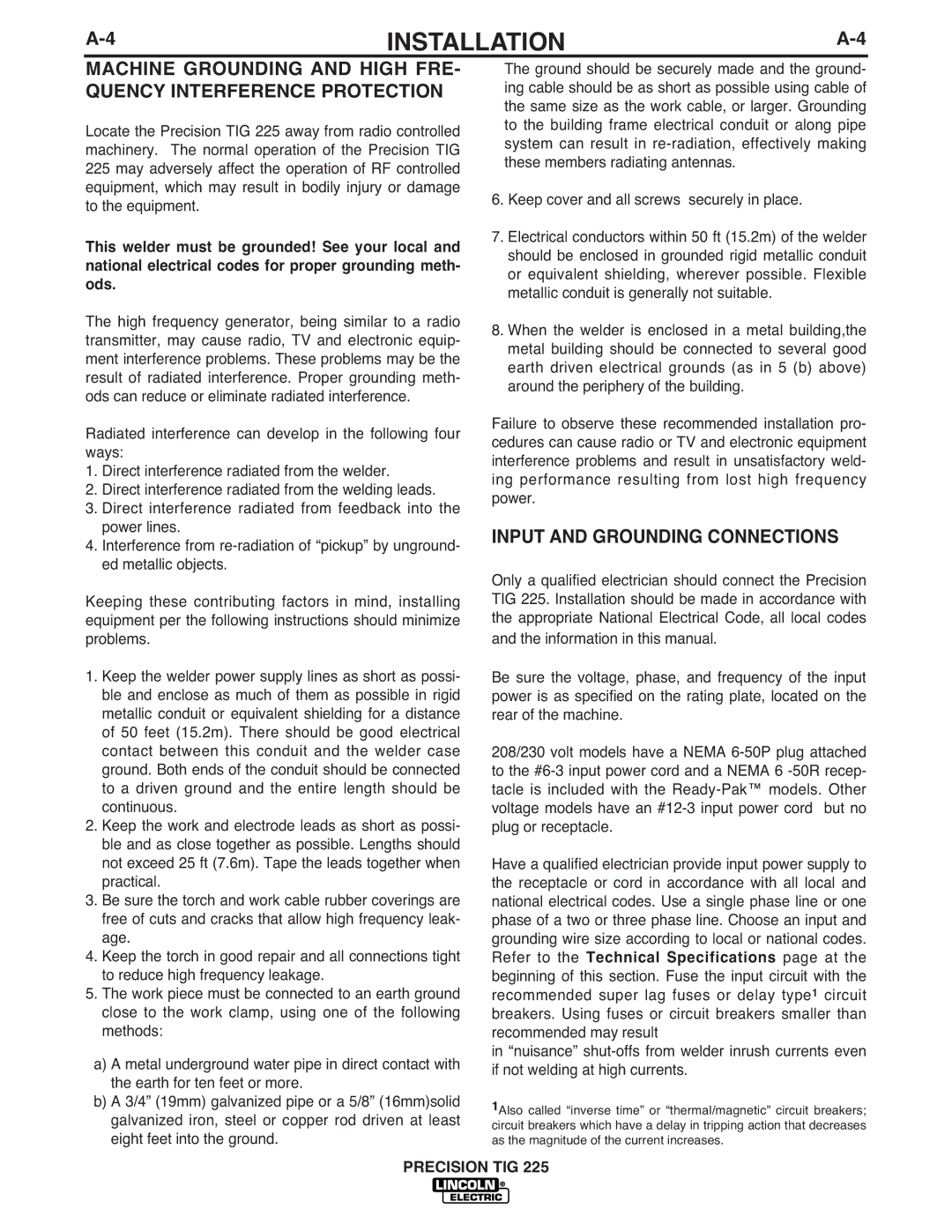INSTALLATION | ||
|
|
|
MACHINE GROUNDING AND HIGH FRE- QUENCY INTERFERENCE PROTECTION
Locate the Precision TIG 225 away from radio controlled machinery. The normal operation of the Precision TIG 225 may adversely affect the operation of RF controlled equipment, which may result in bodily injury or damage to the equipment.
This welder must be grounded! See your local and national electrical codes for proper grounding meth- ods.
The high frequency generator, being similar to a radio transmitter, may cause radio, TV and electronic equip- ment interference problems. These problems may be the result of radiated interference. Proper grounding meth- ods can reduce or eliminate radiated interference.
Radiated interference can develop in the following four ways:
1.Direct interference radiated from the welder.
2.Direct interference radiated from the welding leads.
3.Direct interference radiated from feedback into the power lines.
4.Interference from
Keeping these contributing factors in mind, installing equipment per the following instructions should minimize problems.
1.Keep the welder power supply lines as short as possi- ble and enclose as much of them as possible in rigid metallic conduit or equivalent shielding for a distance of 50 feet (15.2m). There should be good electrical contact between this conduit and the welder case ground. Both ends of the conduit should be connected to a driven ground and the entire length should be continuous.
2.Keep the work and electrode leads as short as possi- ble and as close together as possible. Lengths should not exceed 25 ft (7.6m). Tape the leads together when practical.
3.Be sure the torch and work cable rubber coverings are free of cuts and cracks that allow high frequency leak- age.
4.Keep the torch in good repair and all connections tight to reduce high frequency leakage.
5.The work piece must be connected to an earth ground close to the work clamp, using one of the following methods:
a)A metal underground water pipe in direct contact with the earth for ten feet or more.
b)A 3/4” (19mm) galvanized pipe or a 5/8” (16mm)solid galvanized iron, steel or copper rod driven at least eight feet into the ground.
The ground should be securely made and the ground- ing cable should be as short as possible using cable of the same size as the work cable, or larger. Grounding to the building frame electrical conduit or along pipe system can result in
6.Keep cover and all screws securely in place.
7.Electrical conductors within 50 ft (15.2m) of the welder should be enclosed in grounded rigid metallic conduit or equivalent shielding, wherever possible. Flexible metallic conduit is generally not suitable.
8.When the welder is enclosed in a metal building,the metal building should be connected to several good earth driven electrical grounds (as in 5 (b) above) around the periphery of the building.
Failure to observe these recommended installation pro- cedures can cause radio or TV and electronic equipment interference problems and result in unsatisfactory weld- ing performance resulting from lost high frequency power.
INPUT AND GROUNDING CONNECTIONS
Only a qualified electrician should connect the Precision TIG 225. Installation should be made in accordance with the appropriate National Electrical Code, all local codes and the information in this manual.
Be sure the voltage, phase, and frequency of the input power is as specified on the rating plate, located on the rear of the machine.
208/230 volt models have a NEMA
Have a qualified electrician provide input power supply to the receptacle or cord in accordance with all local and national electrical codes. Use a single phase line or one phase of a two or three phase line. Choose an input and grounding wire size according to local or national codes. Refer to the Technical Specifications page at the beginning of this section. Fuse the input circuit with the recommended super lag fuses or delay type1 circuit breakers. Using fuses or circuit breakers smaller than recommended may result
in “nuisance”
1Also called “inverse time” or “thermal/magnetic” circuit breakers; circuit breakers which have a delay in tripping action that decreases as the magnitude of the current increases.
